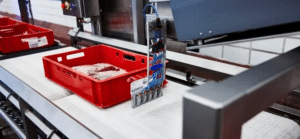Warehousing has come a long way since the days of manual labor and paper-based systems. With the rise of technology, warehouses can now automate many of their processes, resulting in increased efficiency, reduced labor costs, and improved accuracy. Technology is transforming the way warehouses operate from automated storage and retrieval systems to autonomous mobile robots. In this blog post, we will explore how automation is revolutionizing warehousing and the benefits it brings to businesses. We will also discuss some common examples of automation in warehouses and their impact on warehouse operations.
Types of automation in warehouses
As automation in warehouses is becoming increasingly popular there are many types of automation that can be used. Let’s look at a few of the most popular types of automation:
Automated Storage and Retrieval Systems
Automated Storage and Retrieval Systems are a type of robotic system used to store and retrieve goods from high-density storage systems. These systems use a combination of conveyors, elevators, and robotic arms to store and retrieve products. ASRS can increase storage capacity, reduce labor costs, and improve inventory accuracy. ASRS systems can be designed to accommodate a variety of products, including pallets, totes, and cartons. They can also be integrated with warehouse management software to ensure that products are properly stored and retrieved.
Conveyor Systems
Conveyor systems are used to move goods from one location to another within a warehouse. They can be used to move products to and from storage, as well as between different areas of the warehouse. Conveyor systems can improve efficiency and reduce labor costs by reducing the time it takes to move products around the warehouse. They are also a great way to increase safety in the warehouse as they can reduce the risk of injuries associated with manual material handling.

Source: Freepik
Autonomous Mobile Robots
Autonomous Mobile Robots are self-guided robots that can transport goods around a warehouse. They are designed to work collaboratively with workers, and they can improve efficiency and reduce the time it takes to move goods around the warehouse same as conveyor systems. Mobile Robots can be used to transport products to and from storage, pick and pack products for shipping, and move goods to different areas of the warehouse. AMRs are also a great way to improve safety in the warehouse as they can reduce the risk of accidents associated with manual material handling.
Automated Picking and Packing Systems
Automated picking and packing systems use robots and other machinery to pick and pack products for shipping. They can significantly reduce the time it takes to fulfill orders, improve accuracy, and reduce labor costs. Automated picking and packing systems can be customized to accommodate a variety of products and can be integrated with warehouse management software to ensure that orders are properly fulfilled.
Warehouse Management Software
Warehouse management software is an essential tool for any automated warehouse. WMS can be used to track inventory levels, manage warehouse processes, and optimize warehouse operations. WMS can also be integrated with other automation systems, such as automated storage and retrieval systems, to ensure that products are properly stored and retrieved.
PERUZA’S Full layer palletizer
As we discussed earlier, one of the most common types of automation in warehouses is Conveyor Systems. In PERUZA’s range of solutions, you can find different types of conveyor systems. One of them is PERUZA’S Full layer palletizer.
The PERUZA Full layer palletizer is designed to efficiently and delicately prepare and stack entire layers of various products, ranging from small bottles and packages to large boxes and thermoform packages. To form the palette layer as required, the operator inputs the product type into the system. The manipulator then arrives at the location of the product to pick it up, while the layer former feeds the product into the gripper, which then places it onto the palette. If necessary, the manipulator retrieves a separator sheet from the stack and places it onto the palette between each layer. Meanwhile, automatic palette stackers infeed palettes to the robot manipulator station.Finally, ready palettes are conveyed to the next processing stage.
Main benefits of full layer palletizer :
- Fully automated palletizing process
- The line is pre-programmed with necessary product types and variations
- Easy adjustable to new product types and variations
- Continuous workflow with reduced cycle time
Final thoughts
Automation in warehouses has become a necessity for companies looking to improve efficiency, reduce labor costs, and increase accuracy. With the advancements in technology, automation has become more accessible, affordable, and reliable, making it a great investment for businesses of all sizes. Some common examples of automation in warehouses include ASRS, conveyor systems, automated picking and packing systems, and warehouse management software. By implementing these systems, companies can significantly improve their warehouse operations and gain a competitive edge in the market.
As robotics, automation, and machinery develop, you must look into the best possible solutions now. If you’re interested in learning more about how PERUZA can help you get the best results with your food processing, feel free to get in touch at info@peruza.com, and we’ll be happy to discuss the possibilities of us creating something great for your fish processing business!





